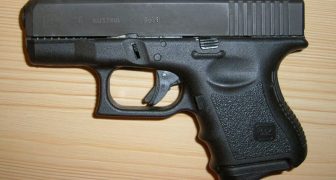This is a guest post by Andrew Betts
The Mighty .357 Magnum
Patton carried one. The numbers 3, 5, 7 alone are synonymous with power. Few cartridges are as universally recognized and respected as the .357 magnum. People might debate 9mm vs. 45 ACP but no one argues the power, versatility, and ability of the mighty .357 mag. It is widely available everywhere that ammunition is sold, from Wal-Mart to Stinky Hank’s Bait Shop, and it can be had in bullet weights ranging from 110 grains through 180 grains. Firearms chambered in .357 mag can also fire .38 spl.
It has been issued by major law enforcement agencies and is still carried by many police officers. With so many more modern choices available, though, is it really a good choice for home defense?
Let us be clear. When it comes to a dedicated home defense gun, size truly doesn’t matter. You may want a gun that is thin, light, and short for carry but those features aren’t necessarily important in a home defense gun. A home defense gun can be much larger. More weight can even be a good thing. Heavier, larger guns absorb recoil more easily and a longer sight radius makes it easier to put those rounds where they need to go. That means that one of the biggest criticisms of a .357 revolver for carry simply doesn’t apply to home defense. That thick cylinder doesn’t have to be wedged against your pelvis so it is not nearly the liability that it would be as a carry gun.To be sure, guns chambered in .357 mag don’t have the capacity that some other guns do. There is no arguing the power that .357 delivers, though. The reputation that 125 gr .357 mag has for making bad people stop doing bad things is well deserved. In this test, a 125 gr JHP slammed into the target at 1,500 feet per second, expanded to well over half an inch, and obliterated a swath of tissue 16” long.
In contrast, this 124 gr 9mm expanded about the same and penetrated nearly as much but hit the target 400 fps slower. The gel cross section clearly shows a dramatic difference in the disruption that was done to the simulated tissue. One grain of difference in bullet weight didn’t cause that. The only significant difference between the two is velocity, and that difference is really monumental. Velocity isn’t everything but velocity is devastating when coupled with substantial mass and a projectile that is tough enough to penetrate deeply and destroy vital organs. Does it really matter that you have 2-3 times as many rounds in your gun if you have to shoot the bad guy 2-3 times as much?
But as we established above, this article is about home defense hand guns, not carry guns. You may choose a handgun as your home defense gun if you don’t have a rifle or shotgun, but long guns are far better suited to home defense. They recoil less, are easier to hit small moving targets with, and when slung, are far easier to retain in a hands on fight. As impressive as .357 mag is when it is fired from a 4”-6” revolver, it is even more impressive when fired from a carbine. It’s not just a longer barrel. Revolvers have a cylinder gap that wastes a lot of gas pressure. With no cylinder gap and a much longer barrel, carbines are able to take full advantage of the velocity potential of the .357 mag. When that velocity is coupled with a tough, well constructed bullet, the result is phenomenal. It almost bridges the gap into intermediate rifle cartridge territory.The difference between the .357 carbine and revolver is every bit as much as the difference we saw between the .357 revolver and 9mm pistol. The damage it did to the gelatin block is consistent with what you see from .223 Rem or 5.56mm except that the last several inches of wound track are caused by a projectile that has expanded to nearly an inch, not just the remains of a ¼” bullet.
To get results like that though, you really have to carefully select the right bullet. Most .357 ammunition is designed to be fired from a handgun and pushing it so much faster often results in over expansion or fragmentation and shallow penetration.
As awesome as that looked, 10” is a little short for defensive use. This load would be a very solid choice for use in a defensive handgun but all that extra velocity from the carbine was just too much for the projectile and resulted in too much expansion and too little penetration.There’s another benefit to a .357 carbine that is often overlooked: the ability to penetrate body armor. Soft armor is designed to stop handgun ammunition at handgun velocity. Depending on the threat level of the vest, it may be rated to stop .357 mag when fired from a revolver but the extra velocity provided by the rifle gives a much better chance of making it through a vest. This level IIA vest is intended to stop 158 gr .357 mag at 1,250 fps but it stood no chance of stopping a 158 gr bullet at 1,800 fps.
Is it really all that likely that you will be attacked by thugs wearing body armor? Of course it isn’t. It isn’t very likely you’ll be attacked at all, yet you still keep a firearm for home defense. Still, It is not unheard of for criminals to wear body armor and if you believe the news, it seems to be growing more common. Few states currently have any restrictions on the possession of body armor and used vests can often be found in pawn shops for very reasonable prices. It might not be likely that you face armored attackers, but having the ability to punch through that armor if you need it is something that you are definitely not going to regret.
It’s also useful that a lever gun is less scary. While I wouldn’t advise someone to intentionally choose a less effective tool just for the sake of not frightening some future, hypothetical jury, it doesn’t hurt that a lever action rifle is less physically imposing than an evil black rifle. No one can argue that you negligently fired too many rounds when you have to manually cycle the action for each shot, either.
Ultimately, there is no “best” home defense gun. The best gun for you is the one you use most effectively. If you choose a .357 for the job of home defense, though, it would be hard to criticize that choice.
Andrew Betts served with the Arizona National Guard for over 12 years, including a tour to Afghanistan. Visit his YouTube Channel for more great shooting information.
Photo credits – Andrew Betts


Speak Your Mind